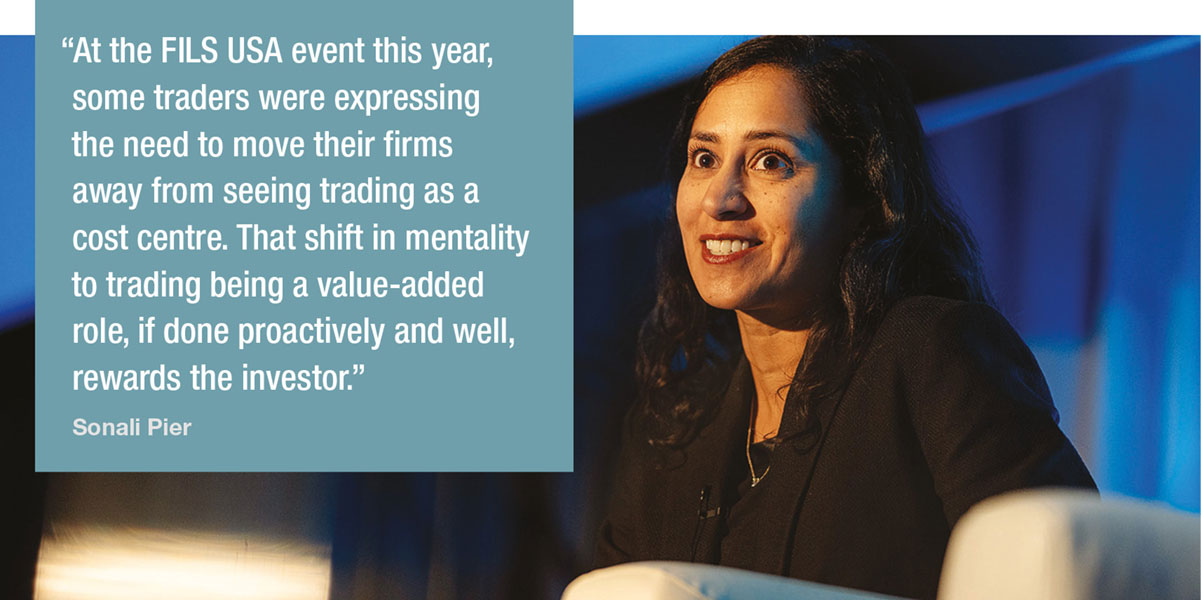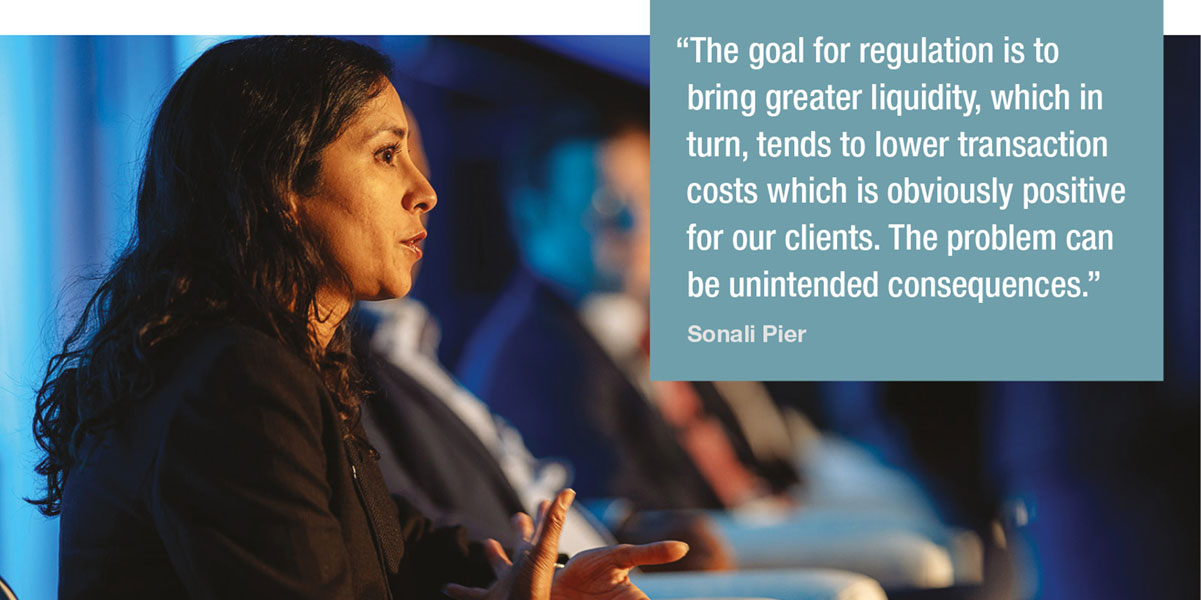Sonali Pier explains how a trader can stand out, and be given a sense of owning the investment process through leadership.
I think that is unique to PIMCO. That group of portfolio managers are our eyes and ears in the market, really working with the dealer community and maintaining relationships. Taking it a step further, we really want them to feel like they co-own the risk.
In practice that might mean noting when a security starts to look rich, or becomes cheap because there’s a block for sale; sharing those technicals and being aware of relative value; understanding where other bonds trade; understanding what issuers need – to the extent they can help work with the research analyst towards a potential reverse inquiry opportunity. That is the value-add.
At the FILS USA event this year, some traders were expressing the need to move their firms away from seeing trading as a cost centre. That shift in mentality to trading being a value-added role, if done proactively and well, rewards the investor.
How is the trading team structured?
At PIMCO all of our traders/portfolio managers are delineated by product. We have merged areas where it makes sense, such as loans and high yield, but they’re always specialists of the product areas they are in.
The desks are then also grouped more broadly within that so that we have an investment grade (IG) portfolio manager, for example, talking to a bank loan portfolio manager because sometimes supply is dependent on how each of these markets are functioning. The specialists in a product view themselves as part of the broader credit team. Similarly in rates, a mortgage specialist understands our macro views on treasuries and rate vol.
For many other firms, functions are in siloes, which can make it difficult to see the markets more holistically and therefore more difficult to find attractive relative value opportunities across markets.
Which instruments are in scope for the business you manage?
The bulk of my assets under management (AUM) is in multi sector credit. That includes our flagship mutual fund offering which is one third IG, one third HY, and one third emerging markets (EM) sovereign and quasi-sovereign. However, we offer a customised approach. Clients may also choose to have different instruments for example mortgages, EM local, non-agencies, bank loans, etc, their custom benchmark. Prior to joining PIMCO in 2013 I mostly focused on high yield, and currently manage some high yield and crossover portfolios as well. As we increasingly try to meet our client needs we’ve had discussions of investing across public and private debt markets.

Which investment mandates are covered in your part of the business, and how does that potentially affect the way that you might be trading?
Here we have everything from mutual funds, separate accounts, hedge funds, closed end funds, interval funds and with that wide scope of product offerings, the liquidity needs vary – the amount of liquidity we need in a mutual fund versus a closed end fund is like day and night. The opportunity set is about maximising value and getting the right opportunities into the right accounts. How we do that is also determined by what are we trading and what liquidity looks like in that instrument. For example, a research analyst will have a fundamental view on a new issue opportunity, then the trader/PM will provide their analysis based on relative value, liquidity and mandate suitability. It’s so important that we’re seeing all available information, so we can fully assess where an investment fits.
Do counterparties understand the breadth and depth of the business?
PIMCO has a strong presence in all fixed income products. Given we have a wide number of mandates including drawdown vehicles and funds with liquidity lock up, we have a place for every type of risk that we find attractive. This wide net is helpful especially during times of significant volatility like we are seeing today.
Sometimes a $300m bond makes sense for a separate account where liquidity is not needed on the total portfolio. If we have other liquid products like CDX alongside, and it’s a $100m account, then that account doesn’t need a very large position for it to be meaningful.
Are cash products and derivatives products typically traded by the same teams?
Single name CDS and cash bonds are traded in the same team. Our cash bond footprint is much larger than our single name CDS footprint. However, we think CDX provides a lot of flexibility and liquidity into our portfolios versus simple bond management.
Within credit we are seeking alpha from security selection, credit selection and industry selection. Within client guidelines, we want to make the most of the flexibility we have. That might mean looking outside of high yield if loans have really sold off, for cheap IG BBBs offering decent relative value or non-agencies offering better downside protection given collateral coverage. CDX offers attractive carry, roll down and liquidity. We think it makes sense to maximise our toolkit when guidelines allow. In those tail opportunities, that flexibility really comes alive.
How is the interaction between trading and lead PMs managed?
We have a lot of touch points for information to be disseminated. I was really excited to join PIMCO because the whole trading floor has access to what was going on in all products in fixed income, and equities. Being able to see what’s going on in other markets is what made multi-sector credit investing exciting and attainable. How we encourage communication is really key to unlocking the full global platform. We rely heavily on email so everyone has equal access to ideas regardless of their time zone.
How do you manage that?
Before I go to bed, I check all the markets in Asia and opportunities that our team has sent out. And when I wake up, I make sure that even before I’ve gotten to the office, I’ve read all the emails from Europe. As a result I feel more ready when I get to the desk with an agenda of what I want to follow up on with our global colleagues. I also have a counterpart based in London so we will co-ordinate for overnight opportunities and with market colour that could be helpful for our portfolios.
As regulators are looking to potentially influence market structure, where you can see the potential for change?
The goal for regulation is to bring greater liquidity, which in turn, tends to lower transaction costs which is obviously positive for our clients. The problem can be unintended consequences. This risk is why regulatory bodies often give advance notice to allow a lot of discussion during a comment period. This is also why it’s important for us to be active in understanding and advocating from our clients’ perspective.

How are you using partnerships to better support the business?
We’re involved in many industry associations. We voice our opinions and discuss the preparation needed to comply with new standards. We also maintain strong relationships with our counterparts. I find market structure really interesting given my prior experience as a sell-side trader, a buy-side trader, and now a portfolio manager. A better understanding of trading and liquidity makes one a better investor.
How do you make adjustments due to market structure?
We want to understand the market structure to build portfolios that can perform in a variety of environments. For example, if bank loans on average are settling T+14, what does that mean if we need to have cash in these portfolios for flows? Perhaps that means we introduce high yield bonds or CDS with a shorter settlement period to dial risk up and down more efficiently alongside the bank loans.
We want to be a liquidity provider in a downturn. If we have built enough flexibility into our portfolio construction, we can be a price setter as opposed to a price taker at a critical time.
A proactive trader and PM will be seeking these types of opportunities, flexibility and making sure they’re getting adequately compensated, for example, for the liquidity premium of an illiquid bond.
How have you seen the profile of your team evolve over the past five years?
Communication skills are still most important for a trading seat, because you really are the funnel through which so much information flows. You have a lot of information from the PMs and from the street, and then you’re choosing what information needs to be exchanged and need to filter that properly.
It is beneficial to have other computer science skills in an evolving marketplace where AI, OMS interoperability, and electronic trading are increasingly important. Having a skill set that includes analytics to sift through a considerable amount of data can be helpful as a good trader tries to identify what signals are valid and helpful.
We are seeing more diversity generally in the industry – diversity has many different aspects – gender, ethnic, socio-economic, etc, which importantly lead to a diversity of thought and approach.
How would you characterise your relationship with both traditional and non-traditional trading counterparties and liquidity providers?
Understanding the type of liquidity you can get from each provider helps you optimise your total access to liquidity. A tier one bank is going to provide greater liquidity but that’s not to say that there’s no place for a smaller liquidity provider. They may be able to work on something for the next week and a half that is tremendously illiquid, which you would not expect from a large liquidity provider. Understanding how to manage your own workflow optimally is to the benefit of our clients.
We’ve embraced portfolio trading for those times when it will be the right tool for the right size account or flow. Market conditions matter. If there are ETF outflows and I need to buy risk in an account, then a portfolio trade may be an easy way to execute a large number of small trades without moving the market.
Are you excited about any trading technologies?
These platforms are looking to enhance liquidity, improve execution, and sift through complex data. For many trading platforms, success depends on the users having a critical mass of the market represented. We ask ourselves is this something that the buy-side cannot do in house or is it so labour intensive that it’s not worth doing in-house?
On a personal level, have there been any sort of formative experiences that helped you in your role?
Bringing something to the table that you can become an expert on quickly. Early in my career, it was very clear that this was a relationship management business and many of my peers had relationships with their clients for 10 or 20 years. I needed to figure out how to distinguish myself to get my foot in the door. All clients want more liquidity, but what makes me the first person they call? So I embraced new products like CDS quickly, and as a result built an edge. While discussing CDS and relative value versus a bond with a client, I would end up getting access to their bond trades as well. Everyone is open to hearing good trade ideas.
Also, when you’re newer to the business or a firm embrace the ‘Yes’. I was glad to sit next to my boss, for example. I’m not afraid of that accountability, and it often leads to more responsibility over time. I don’t want to do my job to not fail. I want to do my job to succeed.
©Markets Media Europe, 2022
TOP OF PAGE

